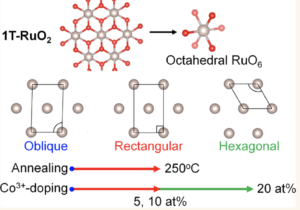
Thermal and Chemical Phase Engineering of Two-Dimensional Ruthenate, 2023, 17, 13, 12305–12315
https://doi.org/10.1021/acsnano.3c01017
Abstract
Monolayer ruthenate nanosheets obtained by exfoliating layered ruthenium oxide exhibit excellent electrical conductivity, redox activity, and catalytic activity, which render them suitable for advanced electronic and energy devices. However, to fully exploit the benefits, we require further structural insights into a complex polymorphic nature and diversity in relevant electronic states of two-dimensional (2D) ruthenate systems. In this study, the 2D structures, stability, and electronic states of 2D ruthenate are investigated on the basis of thermal and chemical phase engineering approaches. We reveal that contrary to a previous report, exfoliation of an oblique 1T phase precursor leads to nanosheets having an identical phase without exfoliation-induced phase transition to a 1H phase. The oblique 1T phase in the nanosheets is found to be metastable and, thus, transforms successively to a rectangular 1T phase upon heating. A phase-controllable synthesis via Co doping affords nanosheets with metastable rectangular and thermally stable hexagonal 1T phases at a Co content of 5–10 and 20 at%, respectively. The 1T phases show metallic electronic states, where the d-d optical transitions between the Ru 4d (t2g) orbital depend on the symmetry of the Ru framework. The Co doping in ruthenate nanosheets unexpectedly suppresses the redox and catalytic activities under acidic conditions. In contrast, the Co2+/3+ redox pair is activated and produces conductive nanosheets with high electrochemical capacitance in an alkaline condition.
